2014 TOYOTA VERSO starting
[x] Cancel search: startingPage 45 of 650
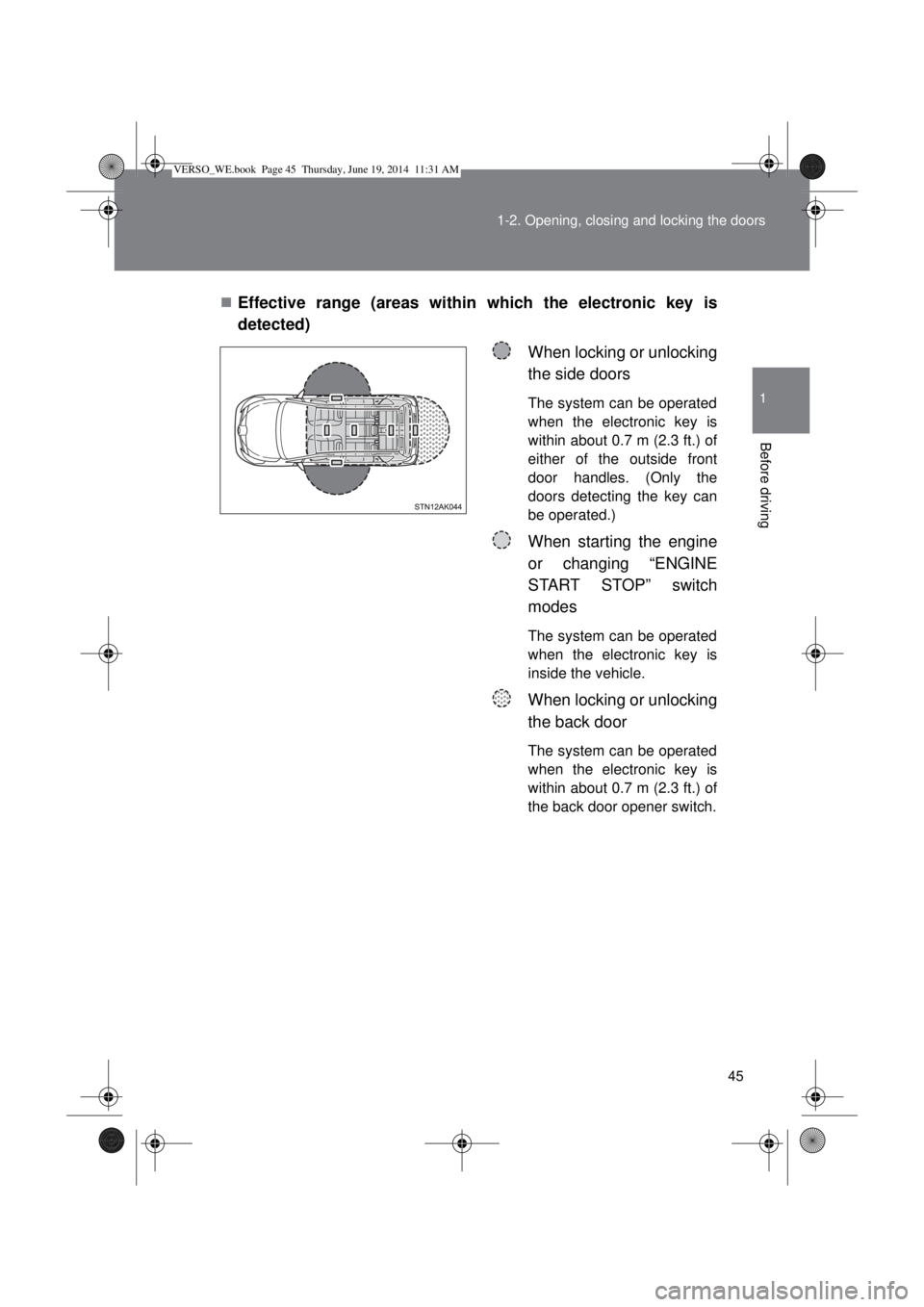
45 1-2. Opening, closing and locking the doors
1
Before driving
Effective range (areas within which the electronic key is
detected)
When locking or unlocking
the side doors
The system can be operated
when the electronic key is
within about 0.7 m (2.3 ft.) of
either of the outside front
door handles. (Only the
doors detecting the key can
be operated.)
When starting the engine
or changing “ENGINE
START STOP” switch
modes
The system can be operated
when the electronic key is
inside the vehicle.
When locking or unlocking
the back door
The system can be operated
when the electronic key is
within about 0.7 m (2.3 ft.) of
the back door opener switch.
VERSO_WE.book Page 45 Thursday, June 19, 2014 11:31 AM
Page 51 of 650
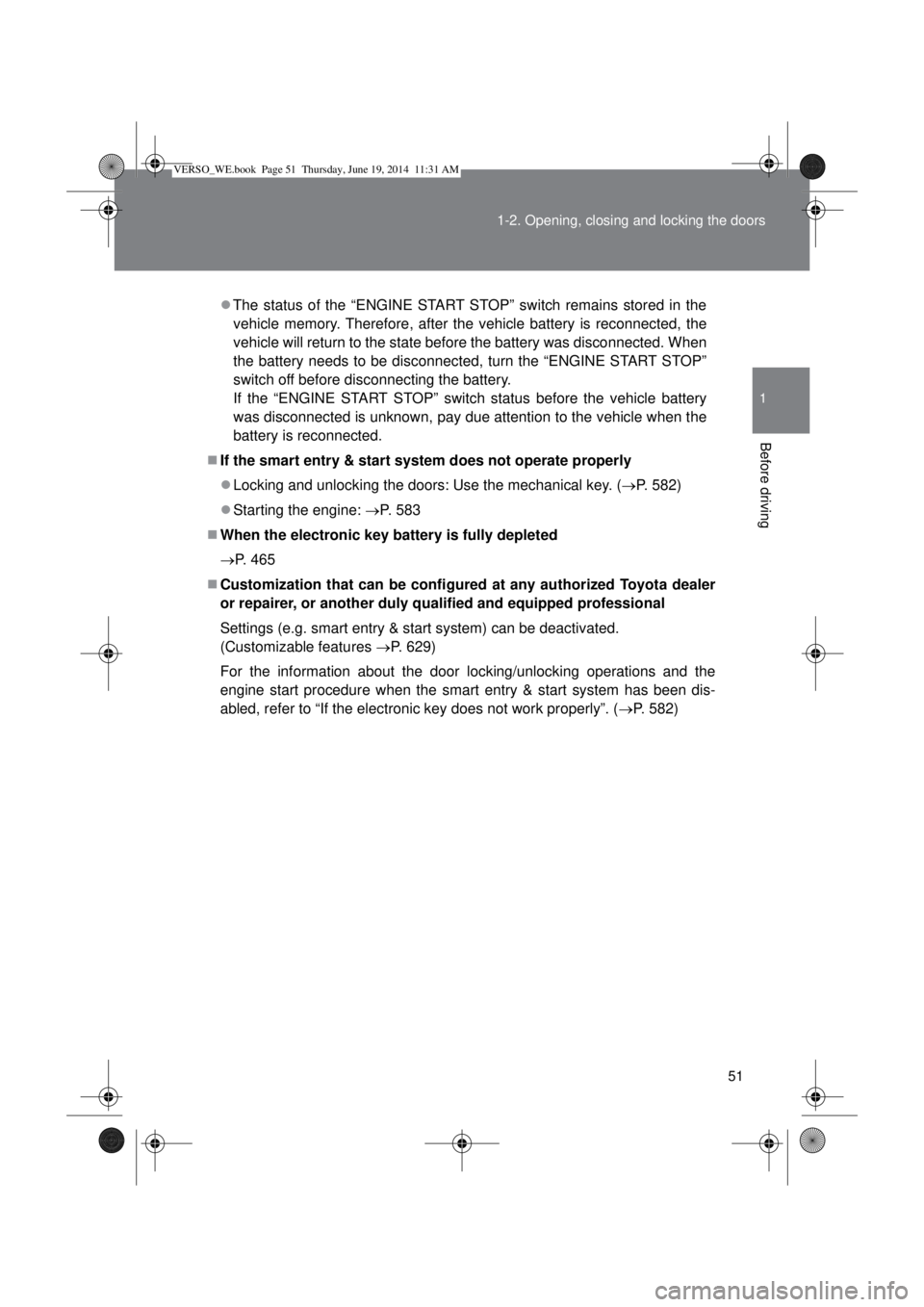
51 1-2. Opening, closing and locking the doors
1
Before driving
The status of the “ENGINE START STOP” switch remains stored in the
vehicle memory. Therefore, after the vehicle battery is reconnected, the
vehicle will return to the state before the battery was disconnected. When
the battery needs to be disconnected, turn the “ENGINE START STOP”
switch off before disconnecting the battery.
If the “ENGINE START STOP” switch status before the vehicle battery
was disconnected is unknown, pay due attention to the vehicle when the
battery is reconnected.
If the smart entry & start system does not operate properly
Locking and unlocking the doors: Use the mechanical key. (P. 582)
Starting the engine: P. 583
When the electronic key battery is fully depleted
P. 465
Customization that can be configured at any authorized Toyota dealer
or repairer, or another duly qualified and equipped professional
Settings (e.g. smart entry & start system) can be deactivated.
(Customizable features P. 629)
For the information about the door locking/unlocking operations and the
engine start procedure when the smart entry & start system has been dis-
abled, refer to “If the electronic key does not work properly”. (P. 582)
VERSO_WE.book Page 51 Thursday, June 19, 2014 11:31 AM
Page 124 of 650
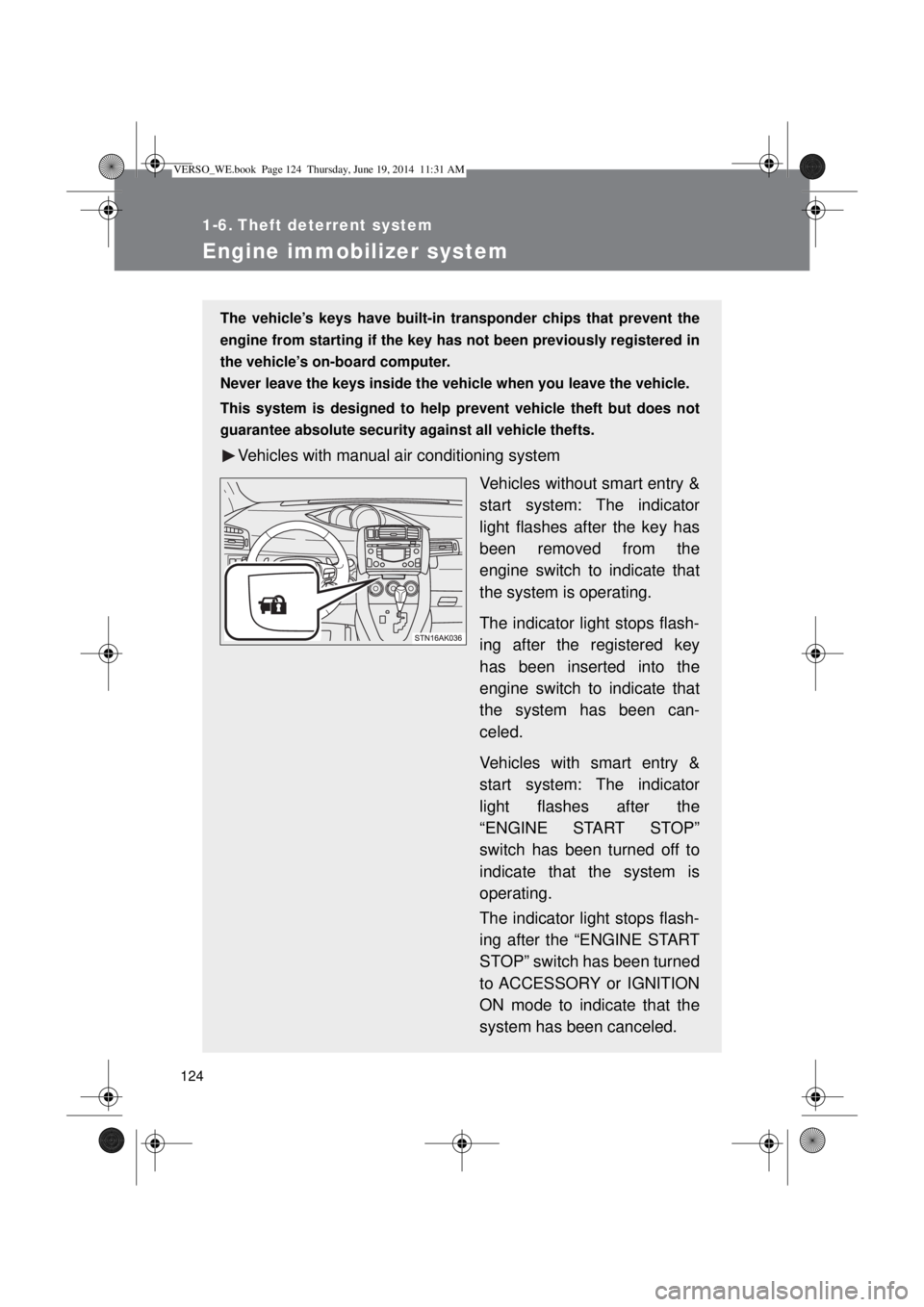
124
1-6. Theft deterrent system
Engine immobilizer system
The vehicle’s keys have built-in transponder chips that prevent the
engine from starting if the key has not been previously registered in
the vehicle’s on-board computer.
Never leave the keys inside the vehicle when you leave the vehicle.
This system is designed to help prevent vehicle theft but does not
guarantee absolute security against all vehicle thefts.
Vehicles with manual air conditioning system
Vehicles without smart entry &
start system: The indicator
light flashes after the key has
been removed from the
engine switch to indicate that
the system is operating.
The indicator light stops flash-
ing after the registered key
has been inserted into the
engine switch to indicate that
the system has been can-
celed.
Vehicles with smart entry &
start system: The indicator
light flashes after the
“ENGINE START STOP”
switch has been turned off to
indicate that the system is
operating.
The indicator light stops flash-
ing after the “ENGINE START
STOP” switch has been turned
to ACCESSORY or IGNITION
ON mode to indicate that the
system has been canceled.
VERSO_WE.book Page 124 Thursday, June 19, 2014 11:31 AM
Page 182 of 650
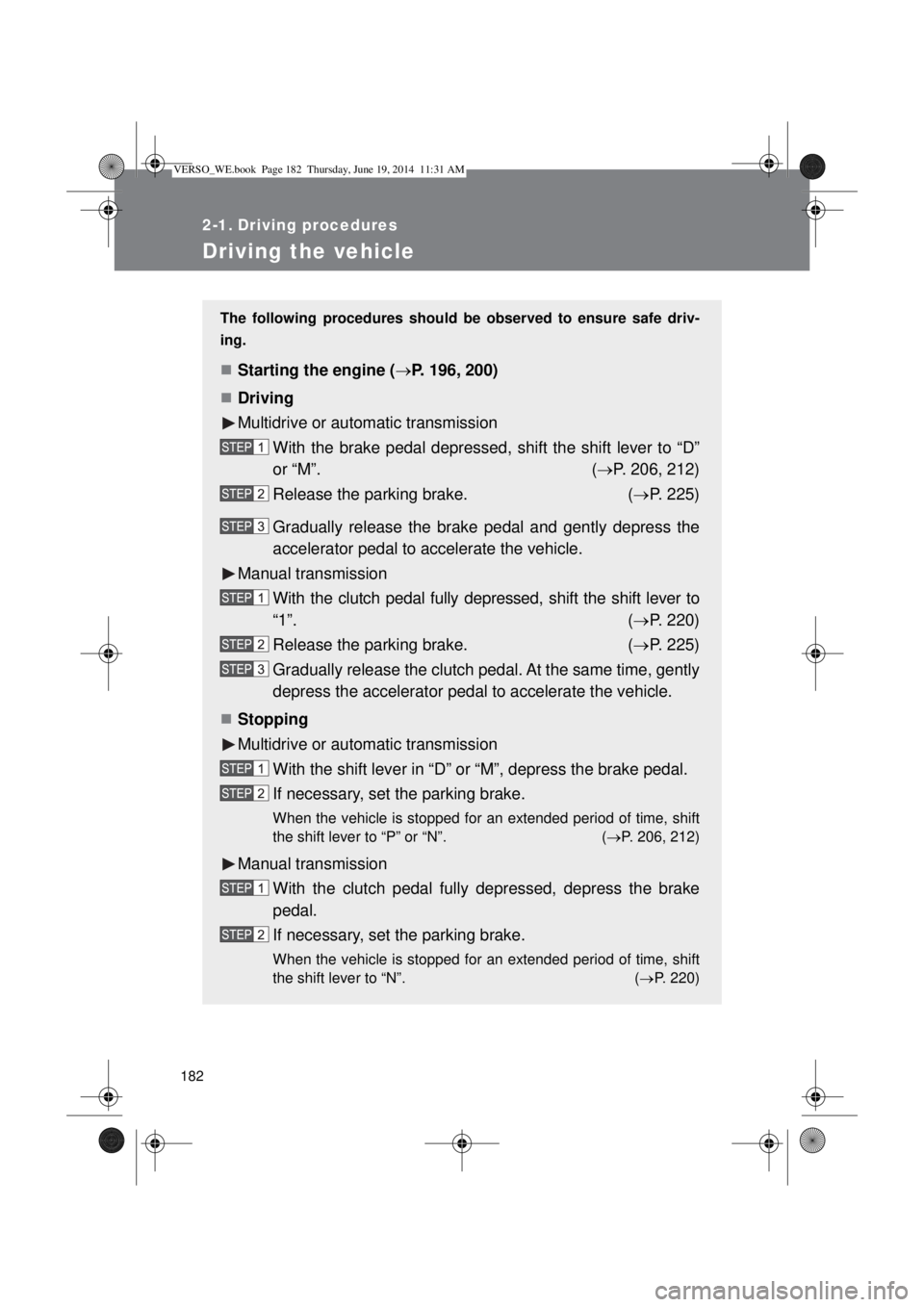
182
2-1. Driving procedures
Driving the vehicle
The following procedures should be observed to ensure safe driv-
ing.
Starting the engine (P. 196, 200)
Driving
Multidrive or automatic transmission
With the brake pedal depressed, shift the shift lever to “D”
or “M”. (P. 206, 212)
Release the parking brake. (P. 225)
Gradually release the brake pedal and gently depress the
accelerator pedal to accelerate the vehicle.
Manual transmission
With the clutch pedal fully depressed, shift the shift lever to
“1”. (P. 220)
Release the parking brake. (P. 225)
Gradually release the clutch pedal. At the same time, gently
depress the accelerator pedal to accelerate the vehicle.
Stopping
Multidrive or automatic transmission
With the shift lever in “D” or “M”, depress the brake pedal.
If necessary, set the parking brake.
When the vehicle is stopped for an extended period of time, shift
the shift lever to “P” or “N”. (P. 206, 212)
Manual transmission
With the clutch pedal fully depressed, depress the brake
pedal.
If necessary, set the parking brake.
When the vehicle is stopped for an extended period of time, shift
the shift lever to “N”. (P. 220)
VERSO_WE.book Page 182 Thursday, June 19, 2014 11:31 AM
Page 184 of 650

184 2-1. Driving procedures
Starting on a steep uphill
Multidrive or automatic transmission
Firmly set the parking brake and shift the shift lever to “D” or
“M”.
Gently depress the accelerator pedal.
Release the parking brake.
Manual transmission
With the parking brake set and the clutch pedal fully
depressed, shift the shift lever to “1”.
Lightly depress the accelerator pedal at the same time as
gradually releasing the clutch pedal.
Release the parking brake. (P. 225)
Hill-Start Assist Control
The hill-start assist control allows you to smoothly start off the vehicle on a
steep or slippery uphill incline. (P. 293)
Driving in the rain
Drive carefully when it is raining, because visibility will be reduced, the
windows may become fogged-up, and the road will be slippery.
Drive carefully when it starts to rain, because the road surface will be
especially slippery.
Refrain from high speeds when driving on an expressway in the rain,
because there may be a layer of water between the tires and the road
surface, preventing the steering and brakes from operating properly.
VERSO_WE.book Page 184 Thursday, June 19, 2014 11:31 AM
Page 187 of 650
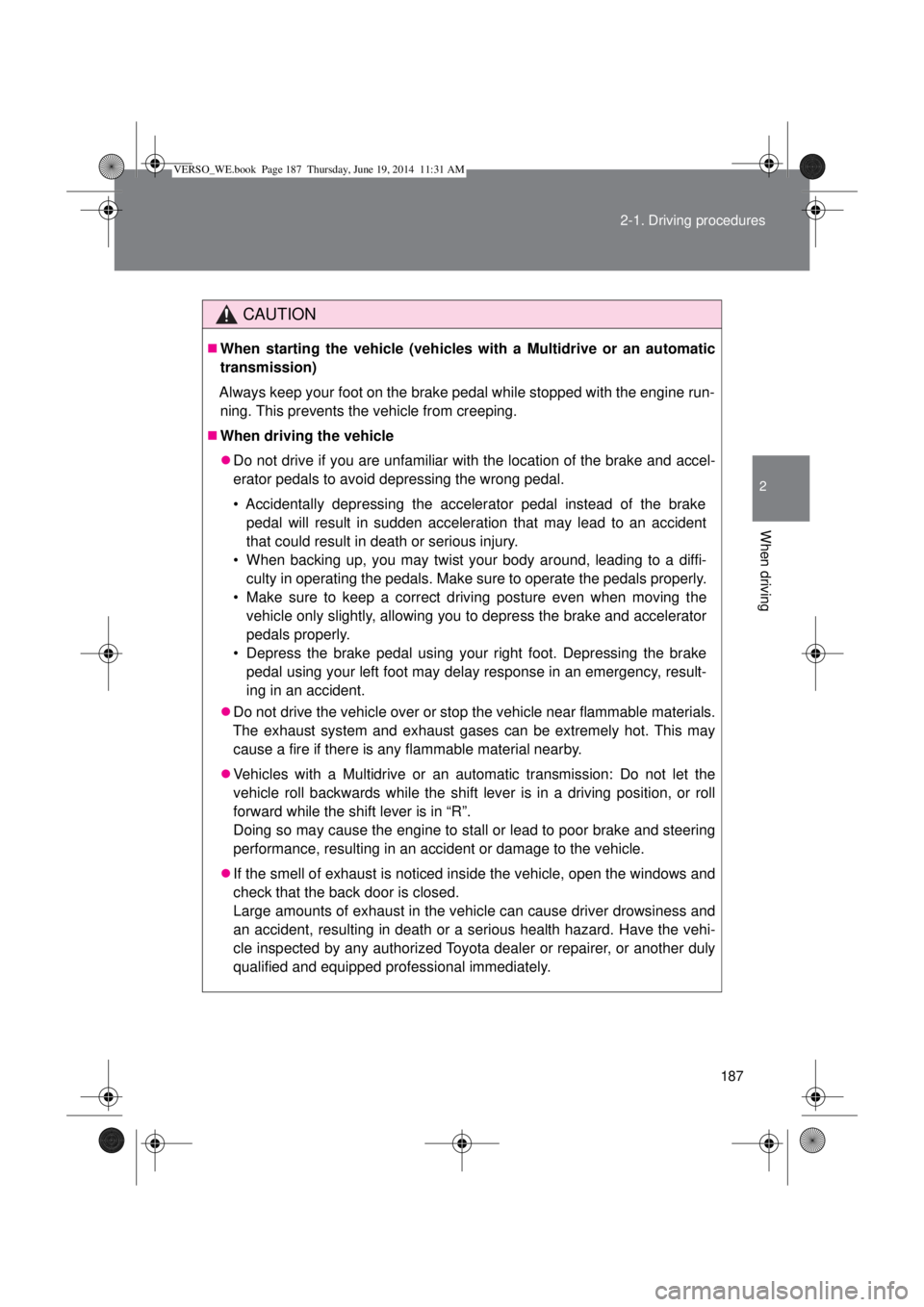
187 2-1. Driving procedures
2
When driving
CAUTION
When starting the vehicle (vehicles with a Multidrive or an automatic
transmission)
Always keep your foot on the brake pedal while stopped with the engine run-
ning. This prevents the vehicle from creeping.
When driving the vehicle
Do not drive if you are unfamiliar with the location of the brake and accel-
erator pedals to avoid depressing the wrong pedal.
• Accidentally depressing the accelerator pedal instead of the brake
pedal will result in sudden acceleration that may lead to an accident
that could result in death or serious injury.
• When backing up, you may twist your body around, leading to a diffi-
culty in operating the pedals. Make sure to operate the pedals properly.
• Make sure to keep a correct driving posture even when moving the
vehicle only slightly, allowing you to depress the brake and accelerator
pedals properly.
• Depress the brake pedal using your right foot. Depressing the brake
pedal using your left foot may delay response in an emergency, result-
ing in an accident.
Do not drive the vehicle over or stop the vehicle near flammable materials.
The exhaust system and exhaust gases can be extremely hot. This may
cause a fire if there is any flammable material nearby.
Vehicles with a Multidrive or an automatic transmission: Do not let the
vehicle roll backwards while the shift lever is in a driving position, or roll
forward while the shift lever is in “R”.
Doing so may cause the engine to stall or lead to poor brake and steering
performance, resulting in an accident or damage to the vehicle.
If the smell of exhaust is noticed inside the vehicle, open the windows and
check that the back door is closed.
Large amounts of exhaust in the vehicle can cause driver drowsiness and
an accident, resulting in death or a serious health hazard. Have the vehi-
cle inspected by any authorized Toyota dealer or repairer, or another duly
qualified and equipped professional immediately.
VERSO_WE.book Page 187 Thursday, June 19, 2014 11:31 AM
Page 193 of 650
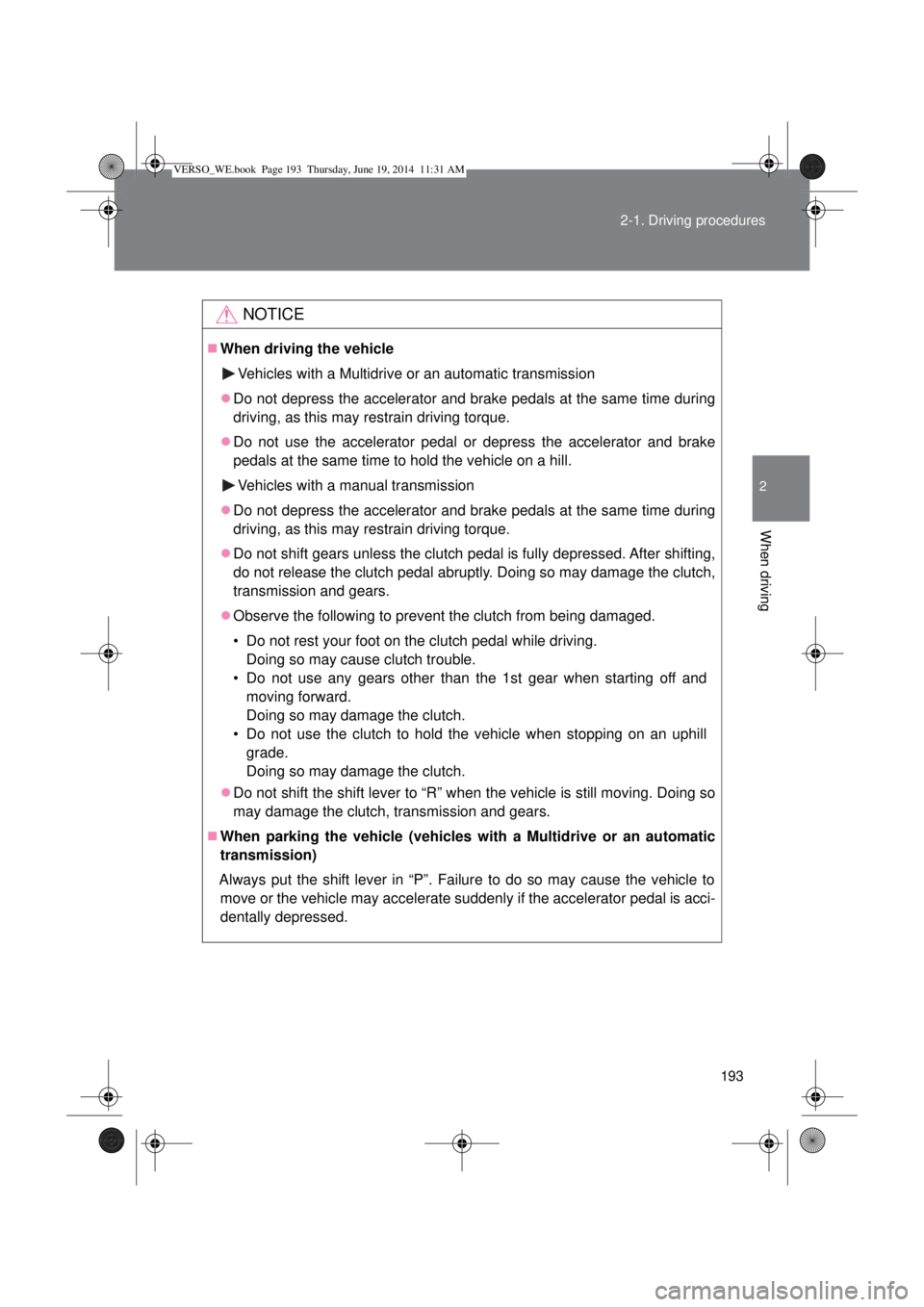
193 2-1. Driving procedures
2
When driving
NOTICE
When driving the vehicle
Vehicles with a Multidrive or an automatic transmission
Do not depress the accelerator and brake pedals at the same time during
driving, as this may restrain driving torque.
Do not use the accelerator pedal or depress the accelerator and brake
pedals at the same time to hold the vehicle on a hill.
Vehicles with a manual transmission
Do not depress the accelerator and brake pedals at the same time during
driving, as this may restrain driving torque.
Do not shift gears unless the clutch pedal is fully depressed. After shifting,
do not release the clutch pedal abruptly. Doing so may damage the clutch,
transmission and gears.
Observe the following to prevent the clutch from being damaged.
• Do not rest your foot on the clutch pedal while driving.
Doing so may cause clutch trouble.
• Do not use any gears other than the 1st gear when starting off and
moving forward.
Doing so may damage the clutch.
• Do not use the clutch to hold the vehicle when stopping on an uphill
grade.
Doing so may damage the clutch.
Do not shift the shift lever to “R” when the vehicle is still moving. Doing so
may damage the clutch, transmission and gears.
When parking the vehicle (vehicles with a Multidrive or an automatic
transmission)
Always put the shift lever in “P”. Failure to do so may cause the vehicle to
move or the vehicle may accelerate suddenly if the accelerator pedal is acci-
dentally depressed.
VERSO_WE.book Page 193 Thursday, June 19, 2014 11:31 AM
Page 196 of 650
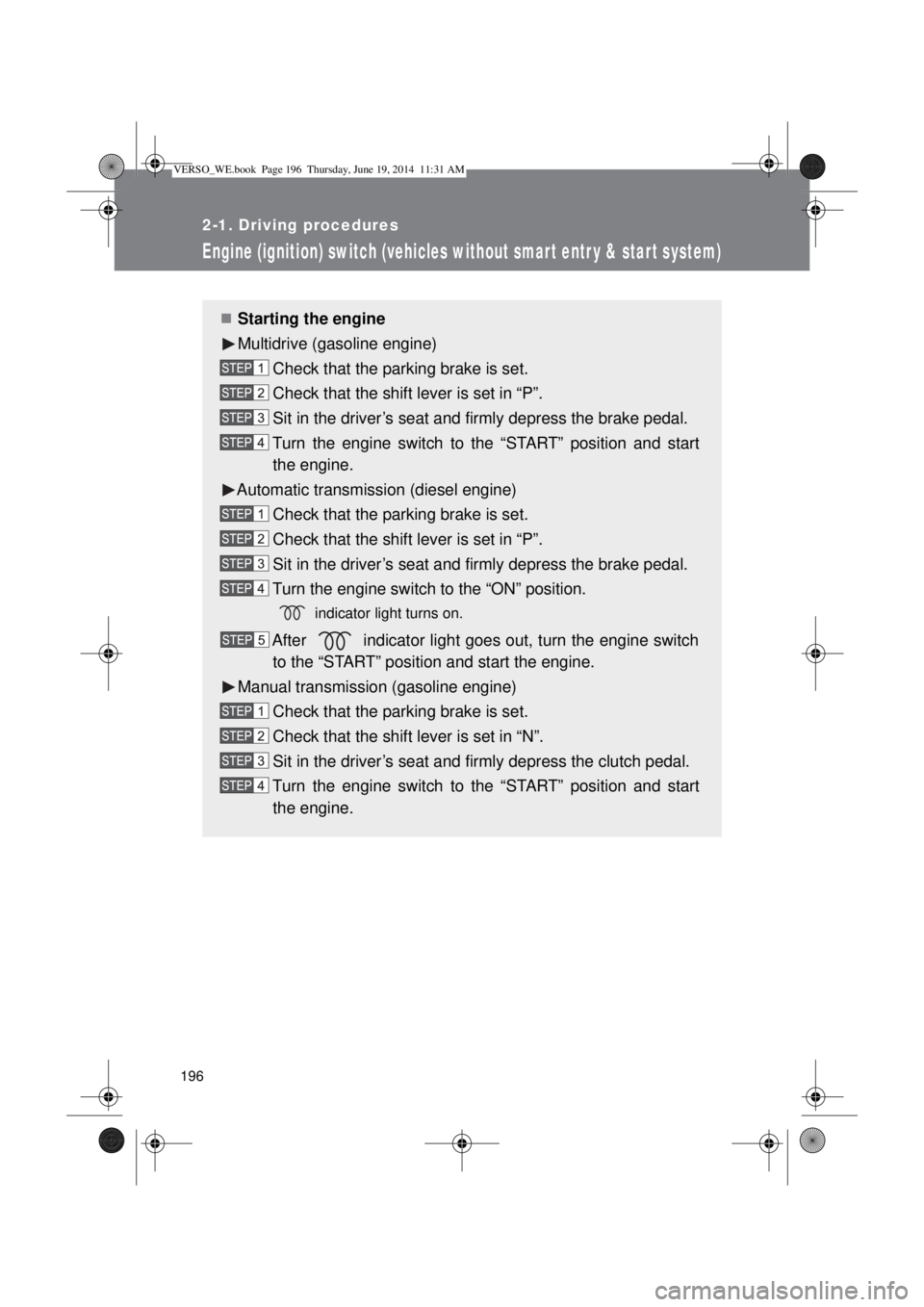
196
2-1. Driving procedures
Engine (ignition) switch (vehicles without smar t entr y & star t system)
Starting the engine
Multidrive (gasoline engine)
Check that the parking brake is set.
Check that the shift lever is set in “P”.
Sit in the driver’s seat and firmly depress the brake pedal.
Turn the engine switch to the “START” position and start
the engine.
Automatic transmission (diesel engine)
Check that the parking brake is set.
Check that the shift lever is set in “P”.
Sit in the driver’s seat and firmly depress the brake pedal.
Turn the engine switch to the “ON” position.
indicator light turns on.
After indicator light goes out, turn the engine switch
to the “START” position and start the engine.
Manual transmission (gasoline engine)
Check that the parking brake is set.
Check that the shift lever is set in “N”.
Sit in the driver’s seat and firmly depress the clutch pedal.
Turn the engine switch to the “START” position and start
the engine.
VERSO_WE.book Page 196 Thursday, June 19, 2014 11:31 AM